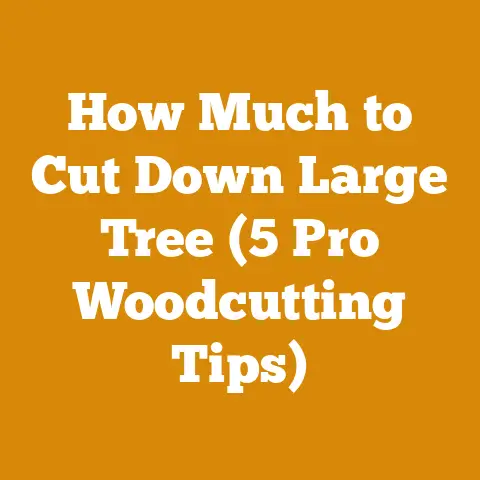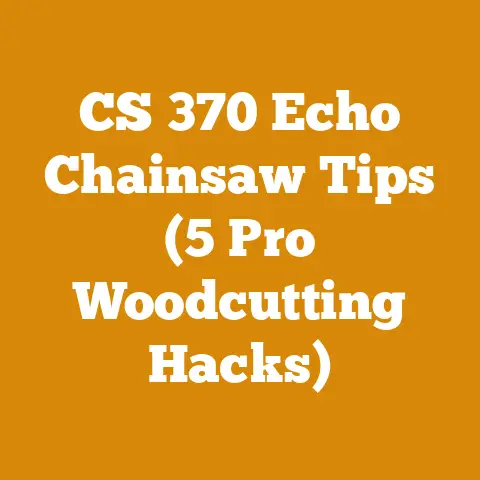Walnut Butt Pricing Tips (Insider Arborist Wood Selling Guide)
What if you stumbled upon a massive walnut tree, the kind that whispers tales of generations past, and at its base, a burl so magnificent it could fetch a king’s ransom? But you’re not quite sure how to navigate the murky waters of pricing and selling such a treasure? That’s where this guide comes in. I’ve been in the wood game for over 20 years, and I’ve seen it all – from folks practically giving away valuable wood to others getting top dollar for what seemed like ordinary logs. Let me share my hard-earned secrets to help you maximize your profit when selling that prized walnut butt.
Walnut Butt Pricing Tips (Insider Arborist Wood Selling Guide)
The global timber market is a dynamic beast. According to recent reports, the demand for high-quality hardwoods, particularly walnut, continues to rise, driven by furniture makers, veneer producers, and specialty woodworkers. The price of walnut lumber has seen fluctuations, influenced by factors like availability, quality, and regional demand. As of late 2023, prices for premium walnut logs have been reaching record highs in certain markets, highlighting the potential for significant returns for those who know how to play the game.
This guide is designed to equip you with the knowledge and strategies needed to understand the value of your walnut butt, negotiate effectively, and ultimately secure the best possible price. I’ll cover everything from assessing the quality and size of your wood to understanding market trends and finding the right buyers. So, let’s dive in.
Understanding Walnut Butt Value
Before you even think about pricing, you need to truly understand what you have. A walnut butt isn’t just a piece of wood; it’s a potential masterpiece waiting to be unveiled. The value hinges on several key factors:
Species and Variety
Black walnut (Juglans nigra) is the most prized species. However, other walnut varieties exist, and their value can differ. Black walnut is known for its rich, dark color, tight grain, and exceptional workability.
Size Matters
Generally, the larger the butt, the more valuable it is. Larger pieces yield wider boards, which are in high demand. Dimensions are measured in diameter and length. A good rule of thumb is to measure the diameter at the narrowest point of the butt.
Grade and Quality
This is where things get interesting. The grade refers to the overall quality of the wood, including the presence of knots, cracks, spalting (a type of fungal discoloration that can add character), and other defects.
- Clear Wood: This is the holy grail – wood with minimal knots and defects. It commands the highest price.
- Select and Better: Allows for a few small knots and minor imperfections.
- Common Grades: These contain more knots and defects and are typically used for less demanding applications.
Grain Pattern and Figure
The grain pattern and figure (the visual appearance of the wood) significantly impact value. Highly figured walnut, such as burl, crotch, or curly walnut, is highly sought after for its unique aesthetic appeal.
- Burl: This is a rounded outgrowth on the tree, often filled with swirling grain patterns. Burls are incredibly valuable.
- Crotch: Where the trunk forks, the grain pattern becomes highly compressed and figured, creating a stunning visual effect.
- Curly/Tiger Stripe: This wavy grain pattern adds depth and dimension to the wood.
Heartwood vs. Sapwood
Heartwood is the darker, denser wood at the center of the tree, while sapwood is the lighter-colored wood near the bark. Heartwood is generally more desirable due to its color and durability. Excessive sapwood can detract from the value.
Moisture Content
Green wood (freshly cut) is much heavier and more prone to warping and cracking than seasoned wood. Buyers typically prefer wood that has been air-dried or kiln-dried to a stable moisture content (around 6-8% for interior use).
Assessing Your Walnut Butt: A Step-by-Step Guide
Now that you know what to look for, let’s get practical. Here’s how to assess your walnut butt:
-
Take Detailed Measurements: Use a measuring tape to accurately measure the diameter (at the narrowest point) and length of the butt. Record these measurements carefully.
-
Inspect for Defects: Thoroughly examine the butt for knots, cracks, rot, insect damage, and other imperfections. Note the size, location, and severity of each defect.
-
Assess Grain Pattern and Figure: Carefully observe the grain pattern and figure. Look for burl, crotch, curly grain, or other unique characteristics. Take photos from different angles to capture the figure.
-
Evaluate Heartwood/Sapwood Ratio: Estimate the proportion of heartwood to sapwood. More heartwood is generally better.
-
Determine Moisture Content: If possible, use a moisture meter to measure the moisture content of the wood. If you don’t have a moisture meter, you can estimate the moisture content based on the age of the wood and how it has been stored. Freshly cut wood will be very heavy and damp, while seasoned wood will be lighter and drier.
-
Document Everything: Create a detailed record of your assessment, including measurements, defect descriptions, grain pattern observations, heartwood/sapwood ratio, and moisture content. Take plenty of high-quality photos.
My Personal Experience: I once acquired a walnut butt that looked unremarkable on the outside. However, after milling it, I discovered a hidden pocket of incredible burl figure deep within. This discovery significantly increased the value of the butt. The lesson? Don’t judge a book by its cover – or a walnut butt by its bark!
Researching Market Prices
Once you’ve assessed your walnut butt, it’s time to do some market research. Knowing what similar pieces are selling for is crucial for setting a realistic price.
Online Marketplaces
- eBay: A good starting point for getting a general sense of prices, but be aware that prices can be highly variable.
- Etsy: More focused on smaller pieces and craft wood, but can provide insights into the value of figured walnut.
- Specialty Wood Forums: Online forums dedicated to woodworking and timber sales can be valuable resources for finding comparable sales.
Local Sawmills and Lumberyards
Contact local sawmills and lumberyards that specialize in hardwoods. Inquire about their current prices for walnut logs and lumber. They may also be interested in purchasing your walnut butt directly.
Arborists and Loggers
Reach out to local arborists and loggers who handle walnut trees. They may have experience selling walnut butts and can provide valuable insights into pricing and market conditions.
Online Timber Auctions
Online timber auctions are gaining popularity. These platforms can provide a competitive bidding environment for your walnut butt.
Checking Recent Sales Data
Keep an eye on recent sales data from auctions, lumberyards, and online marketplaces. This will give you the most up-to-date information on current market prices.
Data Point: A recent study of walnut lumber prices in the Midwest showed a 15% increase in the price of premium-grade walnut over the past year, driven by strong demand from furniture manufacturers.
Pricing Strategies
Now for the big question: How do you actually price your walnut butt? Here are a few strategies to consider:
Price Per Board Foot
This is a common method for pricing lumber and logs. You’ll need to estimate the number of board feet that can be yielded from your walnut butt. A board foot is a unit of volume equal to 144 cubic inches (e.g., 12 inches long x 12 inches wide x 1 inch thick).
-
Estimate Yield: Based on the size and shape of your walnut butt, estimate the number of board feet of lumber you can realistically obtain. Consider the amount of waste that will be generated during milling.
-
Determine Price Per Board Foot: Research the current market price for walnut lumber of similar grade and quality.
-
Calculate Total Price: Multiply the estimated number of board feet by the price per board foot to arrive at a total price.
Price Per Cubic Foot
This method is similar to price per board foot but uses cubic feet as the unit of volume. It can be useful for pricing irregularly shaped pieces.
-
Calculate Cubic Foot Volume: Calculate the volume of your walnut butt in cubic feet.
-
Determine Price Per Cubic Foot: Research the current market price for walnut logs of similar quality, expressed in price per cubic foot.
-
Calculate Total Price: Multiply the cubic foot volume by the price per cubic foot to arrive at a total price.
Negotiating a Fair Price
Negotiation is a crucial part of the selling process. Here are some tips for negotiating effectively:
- Know Your Bottom Line: Before you start negotiating, decide on the minimum price you’re willing to accept.
- Be Confident and Knowledgeable: Present your walnut butt with confidence and be prepared to answer questions about its quality and characteristics.
- Highlight the Unique Features: Emphasize the unique grain patterns, figure, and other desirable features of your walnut butt.
- Be Prepared to Walk Away: Don’t be afraid to walk away from a deal if you’re not getting a fair price.
- Consider Value-Added Services: Offering services like delivery or milling can increase the value of your walnut butt and give you more leverage in negotiations.
Case Study: A small-scale arborist in Oregon successfully sold a large walnut butt with exceptional burl figure for $12,000 by carefully documenting its quality, researching market prices, and negotiating effectively with a high-end furniture maker. This highlights the potential for significant returns with the right approach.
Finding the Right Buyers
Finding the right buyer is just as important as pricing your walnut butt correctly. Here are some potential buyers to consider:
Furniture Makers
High-end furniture makers are often willing to pay top dollar for high-quality walnut with unique grain patterns and figure.
Veneer Producers
Veneer producers use thin slices of wood to create decorative surfaces. They are often interested in walnut butts with exceptional figure.
Woodworkers and Hobbyists
Individual woodworkers and hobbyists may be interested in smaller pieces of walnut for crafting projects.
Sawmills and Lumberyards
Sawmills and lumberyards may be willing to purchase your walnut butt and mill it into lumber for resale.
Online Marketplaces
Online marketplaces like eBay and Etsy can be good options for reaching a wider audience of potential buyers.
Specialty Wood Dealers
Specialty wood dealers specialize in selling rare and exotic woods. They may be interested in purchasing your walnut butt if it has unique characteristics.
Actionable Tip: Network with local woodworking clubs and organizations. These groups are often a good source of potential buyers.
Preparing Your Walnut Butt for Sale
Presentation is key. Properly preparing your walnut butt can significantly increase its appeal to potential buyers.
Cleaning
Remove any dirt, mud, or debris from the surface of the butt. Use a brush or pressure washer to clean it thoroughly.
Sealing
Sealing the ends of the butt with a wax-based sealant can help prevent cracking and checking.
Storing
Store the walnut butt in a cool, dry place away from direct sunlight. This will help prevent warping and discoloration.
Milling (Optional)
Consider having the walnut butt milled into lumber before selling it. This can increase its value, but it also requires specialized equipment and expertise.
Troubleshooting: I’ve seen folks try to dry walnut butts too quickly, leading to severe cracking. Air-drying is generally the best option for larger pieces.
Legal Considerations
Before selling your walnut butt, it’s important to be aware of any legal considerations.
Ownership
Make sure you have clear ownership of the walnut tree from which the butt was harvested.
Permits and Regulations
Check with your local authorities to determine if any permits or regulations apply to the harvesting and sale of timber.
Contracts
Use a written contract to document the terms of the sale, including the price, payment schedule, and delivery arrangements.
Cost and Budgeting Considerations
Selling a walnut butt involves costs that you need to factor into your pricing strategy.
Harvesting Costs
If you harvested the walnut butt yourself, consider the cost of labor, equipment, and transportation.
Milling Costs
If you had the walnut butt milled into lumber, factor in the cost of milling services.
Marketing Costs
Consider the cost of advertising and marketing your walnut butt to potential buyers.
Transportation Costs
Factor in the cost of transporting the walnut butt to the buyer’s location.
Storage Costs
If you need to store the walnut butt before selling it, consider the cost of storage space.
Common Pitfalls to Avoid
Here are some common mistakes to avoid when selling a walnut butt:
- Underestimating Value: Don’t sell yourself short. Do your research and price your walnut butt fairly.
- Overestimating Value: Be realistic about the quality and characteristics of your walnut butt.
- Failing to Prepare Properly: Properly cleaning, sealing, and storing your walnut butt can significantly increase its value.
- Poor Communication: Communicate clearly and professionally with potential buyers.
- Ignoring Legal Considerations: Make sure you comply with all applicable laws and regulations.
Next Steps and Additional Resources
Congratulations! You’re now well-equipped to navigate the world of walnut butt pricing and selling. Here are some next steps to take:
- Assess Your Walnut Butt: Carefully evaluate the quality, size, and characteristics of your walnut butt.
- Research Market Prices: Investigate current market prices for similar pieces.
- Develop a Pricing Strategy: Choose a pricing method and set a realistic price.
- Find Potential Buyers: Identify potential buyers and reach out to them.
- Prepare Your Walnut Butt for Sale: Clean, seal, and store your walnut butt properly.
- Negotiate a Fair Price: Be confident and knowledgeable during negotiations.
- Close the Deal: Use a written contract to document the terms of the sale.
Additional Resources:
- Local Sawmills and Lumberyards: A great place to find buyers and get pricing information.
- Woodworking Clubs and Organizations: A good source of potential buyers and networking opportunities.
- Online Timber Auctions: A competitive platform for selling timber.
- Forestry Extension Services: Provide educational resources and technical assistance.
- Chainsaw Suppliers: Companies like Stihl and Husqvarna offer a wide range of chainsaws for logging and wood processing.
- Drying Equipment Rental Services: Local rental companies often have equipment for drying lumber.
Parting Wisdom: Selling a walnut butt can be a rewarding experience, both financially and personally. By following the tips and strategies outlined in this guide, you can maximize your profit and ensure a successful transaction. Remember, knowledge is power, and with the right approach, you can turn that magnificent walnut butt into a pot of gold! Now, go forth and conquer the wood market!






